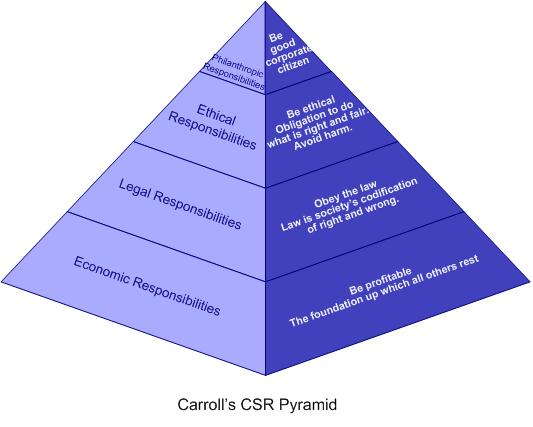Carroll’s CSR Pyramid and its applications to small and medium sized businesses
Carroll’s CSR Pyramid. According to Carroll (1983:608), “corporate social responsibility involves the conduct of a business so that it is economically profitable, law abiding, ethical and socially supportive. To be socially responsible then means that profitability and obedience to the law are foremost conditions when discussing the firm’s ethics and the extent to which it supports the society in which it exists with contributions of money, time and talent”. And the different layers in the pyramid help managers see the different types of obligations that society expects of businesses.
Adopted from: www.csrquest.net/imagefiles/CSR%20Pyramid.jpg
Economic responsibility in Carroll’s CSR Pyramid : It concerns the responsibility of business of producing goods and services needed by society and selling them making a profit. Novak (1996) has contributed to this are by defining seven responsibilities of companies. Companies have shareholders who demand a reasonable return on their investments, they have employees who want safe and fairly paid jobs, and they have customers who demand good quality products at a fair price. So, here comes the first responsibility of the business as it is to be a properly functioning economic unit and stay in business. And this is the base of the pyramid, where all the other layers rest on.
Legal responsibility in Carroll’s CSR Pyramid : the legal responsibility of corporations demands that businesses abide by the law and play by the rules of the game. Should companies choose to “bend” or even ignore their legal responsibilities the price can be very high for the business. And US software giant Microsoft has faced a long running anti-trust case in Europe for abusing its monopolistic position to disadvantage its competitors which resulted in tough settlements against the company.
Ethical Responsibility in Carroll’s CSR Pyramid : the main concept of ethical responsibility as defined and expressed by Carroll (1991) is that the ethical responsibility consists of what is generally expected by society over and above economic and legal expectations. Ethical responsibilities of companies cover its wide range of responsibilities. Ethical responsibilities are not necessarily imposed by law, but they are expected from ethical companies by the public and governments And this case was seen in the example of Shell, where the decision of the government was reversed for disposing of oil platform after a campaign and disagreement by the society and public.
Philanthropic responsibility in Carroll’s CSR Pyramid: as it is in the top of the pyramid, it focuses on more luxurious things such as improving the quality of life of employees, local communities and ultimately society in general. Some points of the philanthropic responsibilities of the businesses can be controversial and requires separate studies aimed to it. For example, who should decide on what cause to spend the money, how much, and on what basis these decisions should be made.
Among comparatively recent theories concerning firm’s social responsibility is “Theory of the firm/strategic leadership theory” which was proposed by Waldman et al (2004). The theory states that some aspects of CEO leadership can have a direct effect on the inclination of firms to engage in CSR and companies which are run by intellectually stimulating CEOs do engage more in strategic CSR than average companies.
References
- Waldman, D, Siegel, D & Javidan, M, 2004, “CEO Transformational Leadership and Corporate Social Responsibility”, Working Paper, Rensselaer Polytechnic Institute

